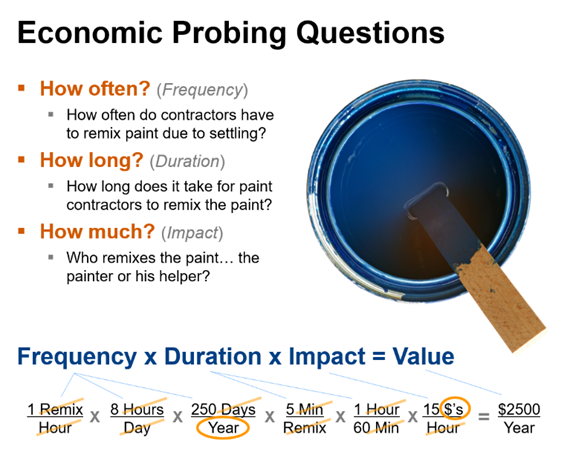3 Questions to gather the financial insights you need.
There are three probing questions you can use during your Discovery and Preference interviews to gather the economic data you need. Keep in mind that these questions often refer to your customers’ process. But they could involve some process down the value chain (e.g. customers’ customers)… or even the process of the final user consuming the product.
How often? (frequency): Imagine you’re recording a problem in a yellow sticky note. You need to know how many times this problem typically occurs. Without this information, you simply have no idea of the customer value you’ll create by eliminating the problem. Examples:
- How often do paint contractors have to remix the paint due to settling?
- How often does the packaging machine break down?
- How many batches of hair gel do you make per shift?
How long? (duration): Sometime a problem occurs and is quickly remedied; in other cases, the “fix” takes a long time. You need this information to understand the value your new product can create by either eliminating the problem or its duration. Examples:
- How long does it take for paint contractors to remix the paint?
- How long is the packaging machine off-line when it breaks down?
- How long does it take to make up each batch of hair gel?
How much? (impact): Now you know how often a problem occurs and how long it lasts. But you need to know the impact… which ultimately is financial in nature. But you may not get dollars-and-cents answers directly from the interviewee. Rather, you may get background information that lets you calculate the financial impact later. For instance, in the following paint example, you might not ask “How much do painters earn per hour?” But instead, you’d learn if it’s the higher-paid painter—or his helper—who is performing the task. Later, you can research typical hourly rates for these workers.
- Who remixes the paint… the painter or his helper?
- How is your production capacity impacted when the packaging machine breaks down?
- Is the operator typically doing other work while the hair gel is mixing?

You may not need to ask all three questions to get the economic data you’ll need: You may already know some of this from other sources. But keep this formula in mind on every outcome you probe:
Frequency x Duration x Impact = Value
Here’s an example:
1 Paint remixing per hour (frequency) x 8 hrs/day x 250 days/yr
x 5 Minutes interruption per remixing (duration) x 1 hour/60 minutes
x $15 per hour (impact)
= $2500 lost contractor labor value per year
Here’s a simple trick to get your math is right: Look at the illustration and you’ll see you can cross out units if they appear in both the numerator and the denominator. In this case, you can cross out Remix, Hours, Days, and Minutes. All that’s left is Dollars per year… which is what you’re looking for.
For more on the creation of value calculators, see e-Module 8: Creating & Capturing Value at www.blueprintingcenter.com > e-Learning. Also check out the 2-minute video, Build your interviewing skills, part of the B2B Organic Growth video series by Dan Adams.
Keywords: value calculator, economic data, financial data, new product pricing, probing questions, how often, how long, how much, frequency, duration, impact, economic probing questions
